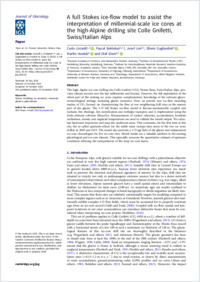A full Stokes ice-flow model to assist the interpretation of millennial-scale ice cores at the high-Alpine drilling site Colle Gnifetti, Swiss/Italian Alps
- Licciulli, Carlo Bavarian Academy of Sciences and Humanities, Munich, Germany - Institute of Environmental Physics (IUP), Heidelberg University, Heidelberg, Germany
- Bohleber, Pascal Institute of Environmental Physics (IUP), Heidelberg University, Heidelberg, Germany - Institute for Interdisciplinary Mountain Research, Austrian Academy of Sciences, Innsbruck, Austria
- Lier, Josef Institute of Environmental Physics (IUP), Heidelberg University, Heidelberg, Germany - Institute for Interdisciplinary Mountain Research, Austrian Academy of Sciences, Innsbruck, Austria
- Gagliardini, Olivier Univ. Grenoble Alpes, CNRS, IRD, Grenoble INP, IGE, Grenoble, France
- Hoelzle, Martin Department of Geosciences, University of Fribourg, Fribourg, Switzerland
- Eisen, Olaf Department of Geosciences, University of Bremen, Bremen, Germany - Glaciology, Department of Geosciences, Alfred Wegener Institute, Helmholtz Centre for Polar and Marine Research, Bremerhaven, Germany
-
19.11.2019
Published in:
- Journal of Glaciology. - 2020, vol. 66, no. 255, p. 35–48
English
The high-Alpine ice-core drilling site Colle Gnifetti (CG), Monte Rosa, Swiss/Italian Alps, provides climate records over the last millennium and beyond. However, the full exploitation of the oldest part of the existing ice cores requires complementary knowledge of the intricate glacio-meteorological settings, including glacier dynamics. Here, we present new ice-flow modeling studies of CG, focused on characterizing the flow at two neighboring drill sites in the eastern part of the glacier. The3-D full Stokes ice-flow model is thermo-mechanically coupled and includes firn rheology, firn densification and enthalpy transport, and is implemented using the finite element software Elmer/Ice. Measurements of surface velocities, accumulation, borehole inclination, density and englacial temperatures are used to validate the model output. We calculate backward trajectories and map the catchment areas. This constrains, for the first time at this site, the so-called upstream effects for the stable water isotope time series of the two ice cores drilled in 2005 and 2013. The model also provides a 3- D age field of the glacier and independent ice-core chronologies for five ice-core sites. Model results are a valuable addition to the existing glaciological and ice-core datasets. This especially concerns the quantitative estimate of upstream conditions affecting the interpretation of the deep ice-core layers.
- Faculty
- Faculté des sciences et de médecine
- Department
- Département de Géosciences
- Language
-
- English
- Classification
- Hydrology
- License
- License undefined
- Identifiers
-
- RERO DOC 328196
- DOI 10.1017/jog.2019.82
- Persistent URL
- https://folia.unifr.ch/unifr/documents/308358
Statistics
Document views: 71
File downloads:
- hoe_fsi.pdf: 149
